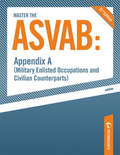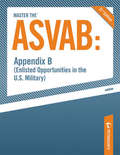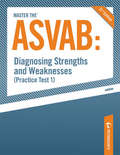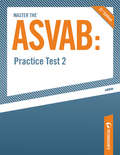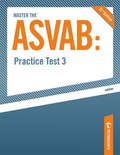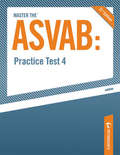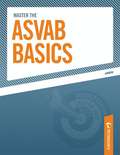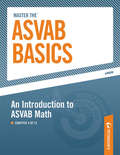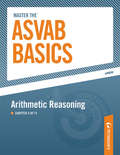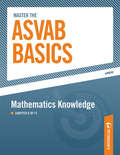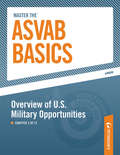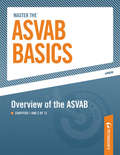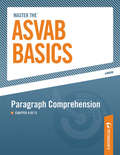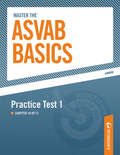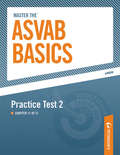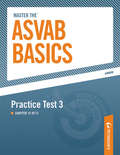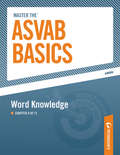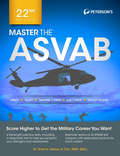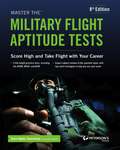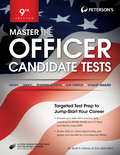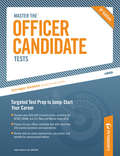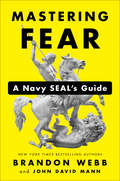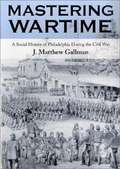- Table View
- List View
Master the ASVAB - Appendix A: Military Enlisted Occupations and Civilian Counterparts
by Scott A. OstrowContains updated information about military careers and different occupations.
Master the ASVAB - Appendix B: Enlisted Opportunities in the U.S. Military
by Scott A. OstrowDiscusses updated information on enlisting, military training, duty assignment, pay scales and grades, and benefits.
Master the ASVAB - Diagnosing Strengths and Weaknesses (Practice Test #1)
by Scott A. OstrowThis diagnostic test contains questions from all nine sections of the ASVAB.
Master the ASVAB - Practice Test 3
by Scott A. OstrowA full length practice exam of the ASVAB with questions from all nine sections.
Master the ASVAB - Practice Test 4
by Scott A. OstrowA full length practice exam of the ASVAB with questions from all nine sections.
Master the ASVAB Basics
by Peterson'sJump-start your career and get the ASVAB scores you need. Peterson's book contains extensive details on the AFQT (Armed Forces Qualification Test: Arithmetic Reasoning, Mathematics Knowledge, Word Knowledge, and Paragraph Comprehension). Here you can find expert test-taking strategies, study skills, and current information on career opportunities in all branches of the U.S. military.
Master the ASVAB Basics--An Introduction to ASVAB Math: Chapter 4 of 12
by Peterson'SPeterson's provides a useful introduction to ASVAB Math. Arithmetic Reasoning and Mathematics Knowledge exercises are included in this brief review, along with general math tips and four test-taking tips for the ASVAB Math subtests.
Master the ASVAB Basics--An Introduction to ASVAB Verbal: Chapter 7 of 12
by Peterson'SPeterson's provides a useful introduction to ASVAB Verbal. Word Knowledge and Paragraph Comprehension exercises are included in this brief review, along with general verbal tips and six test-taking tips for the ASVAB Verbal subtests.
Master the ASVAB Basics--Arithmetic Reasoning: Chapter 5 of 12
by Peterson'SPeterson's provides an in-depth review of Arithmetic Reasoning exercises in the ASVAB. Decimals and whole numbers, making purchases, fractions and percents, numbers with units, parts of a whole, ratio and proportion, averages, and graphs problems are included.
Master the ASVAB Basics--Mathematics Knowledge: Chapter 6 of 12
by Peterson'SPeterson's provides an in-depth review of Mathematics Knowledge exercises in the ASVAB. Algebra; signed numbers; formulas; circles and quadrilaterals; triangles; powers, roots, and radicals; exponents and sequences problems are included.
Master the ASVAB Basics--Overview of U.S. Military Opportunities: Chapter 3 of 12
by Peterson'SHere you can access important facts and figures on enlisted opportunities in the U.S. military. Updated content on enlistment programs and contracts, military training, servicemembers opportunity colleges, and pay and benefits are all included in this helpful e-book.
Master the ASVAB Basics--Overview of the ASVAB
by Peterson'sPeterson's essential introduction to the ASVAB provides information on preparing for and taking the ASVAB, details on the AFQT (Armed Forces Qualification Test), and a preview of the rest of the book. There is also valuable information about percentile and composite scoring.
Master the ASVAB Basics--Paragraph Comprehension: Chapter 9 of 12
by Peterson'SPeterson's provides an in-depth review of Paragraph Comprehension exercises in the ASVAB. Finding main ideas, looking for details, making inferences, finding word meanings problems are included.
Master the ASVAB Basics--Practice Test 1: Chapter 10 of 12
by Peterson'SOur Practice Test is the AFQT (Armed Forces Qualification Test) drawn from the ASVAB, including all four AFQT sections (Arithmetic Reasoning, Mathematics Knowledge, Word Knowledge, and Paragraph Comprehension) with detailed answer explanations.
Master the ASVAB Basics--Practice Test 2: Chapter 11 of 12
by Peterson'SOur Practice Test is the AFQT (Armed Forces Qualification Test) drawn from the ASVAB, including all four AFQT sections (Arithmetic Reasoning, Mathematics Knowledge, Word Knowledge, and Paragraph Comprehension) with detailed answer explanations.
Master the ASVAB Basics--Practice Test 3: Chapter 12 of 12
by Peterson'SOur Practice Test is the AFQT (Armed Forces Qualification Test) drawn from the ASVAB, including all four AFQT sections (Arithmetic Reasoning, Mathematics Knowledge, Word Knowledge, and Paragraph Comprehension) with detailed answer explanations.
Master the ASVAB Basics--Word Knowledge
by Peterson'sPeterson's essential introduction to the ASVAB provides information on preparing for and taking the ASVAB, details on the AFQT (Armed Forces Qualification Test), and a preview of the rest of the book. There is also valuable information about percentile and composite scoring.
Master the ASVAB, 22nd Edition
by Scott OstrowNewly updated, Peterson's Master the ASVAB is a comprehensive guide that provides extensive review and practice tests, top-notch study tips and strategies, along with updated information on changes to the AFQT exam. This guide provides: Four full-length ASVAB practice tests, including a diagnostic test Coverage of all ASVAB test subjects, with dedicated sections for each subtest. Extensive detail on the AFQT sections (Armed Forces Qualification Test, comprising two verbal and two math sections) Comprehensive information about the ASVAB and military occupations, including:-updated information about test changes-review and practice exams for every subject test-updated information on enlisting, military training, duty assignment, pay scales and grades, and benefits-profiles of more than 125 military careers
Master the Military Flight Aptitude Tests
by Peterson'sAdmission to a U.S. military flight training program is highly competitive, and Peterson's Master the Military Flight Aptitude Tests offers exactly what a candidate needs to ace the military flight aptitude tests. In addition to in-depth subject reviews-covering everything from Instrument Comprehension and Cyclic Orientation to Scale Reading and Complex Movements-this eBook also boasts expert test-taking tips and strategies and essential information on test structure, scoring, and passing requirements. Three full-length practice tests cover all subject and question types that you will encounter on the offical exams. You can also find detailed descriptions of flight training programs for the Air Force, Coast Guard, Marine Corps, Army, and Navy, plus data on career opportunities as a military pilot, flight officer, airplane navigator, and helicopter pilot.
Master the Officer Candidate Tests
by Peterson'sEach year, the U.S. Armed Forces commissions thousands of new officers. Peterson's Master the Officer Candidate Tests provides candidates with the preparation they need to achieve success on the required qualifying exams. Inside you'll find expert strategies and review along with 3 practice tests, including the AFOQT, ASVAB, and U.S. Navy and Marine Corps ASTB to help you test your best. This comprehensive resource includes must-know information on the structure and content of all officer candidate tests, as well as important details on branch-specific commissioning requirements for the Army, Navy, Air Force, Marine Corps, and Coast Guard. Review data on career opportunities, pay grades, and benefits for commissioned officers-everything you need to know to help you earn your commission!
Master the Officer Candidate Tests
by Scott A. OstrowPeterson's Master the Officer Candidate Tests is the all-in-one source for your test preparation to become an officer in the U.S. military. The book offers essential information about the career opportunities, pay and benefits, and commissioning requirements, going into details about each branch of the armed forces. You will learn about the different officer training schools and their expectations, available career fields, and requirements and qualifications for admittance. After becoming familiar with the structure and content of the officer candidate tests, you will start your test preparation with invaluable tips and strategies for taking the test and sample items for each question type. This valuable guide offers nine practice tests with detailed answer explanations for each question. These are essential for helping you learn from your mistakes. In addition, there are three officer candidate tests that mimick the official exams in format and structure. While they are not meant to be comprehensive, the will give you a clear approximation of essential sections from actual exams.
Mastering Fear: A Navy SEAL's Guide
by John David Mann Brandon WebbFrom New York Times bestselling author and former Navy SEAL Brandon Webb comes a simple yet powerful five-step guide to transforming your life by making your fears work for you instead of against you.Brandon Webb has run life-threatening missions in the world's worst trouble spots, whether that meant jumping out of airplanes, taking down hostile ships on the open sea, or rolling prisoners in the dead of night in the mountains of Afghanistan. As a Navy SEAL, he learned how to manage the natural impulse to panic in the face of terrifying situations. As media CEO and national television commentator, he has learned how to apply those same skills in civilian life. Drawing on his experiences in combat and business, along with colorful anecdotes from his vast network of super-achiever friends from astronauts to billionaires, Webb shows how people from all walks of life can stretch and transcend their boundaries and learn to use their fears as fuel to achieve more than they ever thought possible. "Fear can be a set of manacles, holding you prisoner," writes Webb. "Or it can be a slingshot, catapulting you on to greatness."The key, says Webb, is not to fight fear or try to beat it back, but to embrace and harness it. In the process, rather than being your adversary, your fear becomes a secret weapon that allows you to triumph in even the most adverse situations. In Mastering Fear, Webb and his bestselling coauthor John David Mann break this transformation down into five practical steps, creating a must-read manual for anyone looking for greater courage and mastery in their lives.
Mastering Wartime: A Social History of Philadelphia during the Civil War
by J. Matthew GallmanMastering Wartime is the first comprehensive study of a Northern city during the Civil War. J. Matthew Gallman argues that, although the war posed numerous challenges to Philadelphia's citizens, the city's institutions and traditions proved to be sufficiently resilient to adjust to the crisis without significant alteration. Following the wartime actions of individuals and groups-workers, women, entrepreneurs-he shows that while the war placed pressure on private and public organizations to centralize, Philadelphia's institutions remained largely decentralized and tradition bound. Gallman explores the war's impact on a wide range of aspects of life in Philadelphia. Among the issues addressed are recruitment and conscription of soldiers, individual responses to wartime separation and death, individual and institutional benevolence, civic rituals, crime and disorder, government contracting, and long-term economic development. The book compares the wartime years to the antebellum period and discusses the war's legacies in the postwar decade.
Mastering the Ultimate High Ground: Next Steps in the Military Uses of Space
by Benjamin S. LambethAssesses the military space challenges facing the Air Force and the nation in light of the findings and recommendations of the Space Commission. The author reviews the Air Force?'s involvement in space since its creation as an independent service in 1947; examines the circumstances that occasioned the commission?'s creation and the conceptual and organizational roadblocks that have impeded a more rapid growth of U.S. military space capability; and enumerates the challenges facing the Air Force with respect to space.
